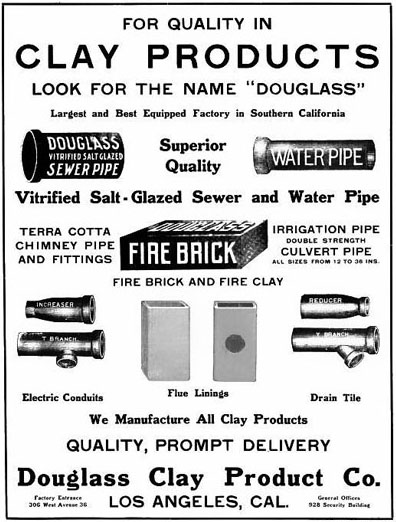In 1896, Archibald Douglass arrived in Los
Angeles and became president and treasurer of the Los Angeles Stoneware
and Sewer Pipe Company, which had established a stoneware and sewer pipe
manufacturing plant at 320/423 Avenue 26 in Los Angeles in 1891.
Douglass was born in Fort Madison, Iowa, in 1859. In 1872, his parents
moved to St. Louis, Missouri, where his father was employed as a lumber
merchant. In 1883, he married Frances Kaime, and they raised two sons
and a daughter. The family went to Los Angeles, California, in 1896.
Douglass held the president and treasurer positions at the Los Angeles
Stoneware and Sewer Pipe Company until 1905.
By 1906, Douglass
had taken over the company through stock acquisitions and he decided to
reorganize it under a new company which he called the Douglass Clay
Product Company. The new company was incorporated on December 18, 1907,
with a capital stock of $250,000. The directors were Archibald Douglass,
Benjamin Douglass, C.R. Manbert, Norman A. Bailie, and Benjamin Kirby,
all of Los Angeles. Officers included Archibald Douglass as president
and treasurer, Donald Barker as vice-president, and Edwin Bird as
secretary. The office was at the Pacific Electric Building at 604 South
Main Street in Los Angeles. F.A. Mann was the sales manager. The purpose
was to manufacture all kinds of clay products, including sewer pipe,
firebrick, pottery, glazed brick, terra cotta, stoneware, and glassware.
The focus here will be on the bricks manufactured at this plant.
In May 1906, the Douglass Clay Product Company took out a mortgage of
$100,000, due in five years, for updating the plant. The plant was
described as being the best equipped in its special lines in the West.
The main two-story building covered two acres of the seven-acre
property. The foundations were of concrete and the clay processing plant
rose to four stories in height. Crude oil was used in the power plants
and for the kilns. Oil was stored in two 1,500-gallon barrel tanks. The
boiler plant contained three 120-h.p. return tubular boilers made by the
Bass Foundry and Machinery Company, with a condensing plant that
returned water to the boilers. A Bass-Corliss 120 h.p. engine was used
to power the plant's machinery. A Laidlaw-Dunn-Gordon air compressor
supplied compressed air for burning the kilns. A smaller engine ran the
electric plant. They also had a complete blacksmith and machine shop for
repairing machinery and tools. A laboratory was equipped for analyzing
and testing 40 different clays.
Clay was delivered from their own 80-acre clay property near Elsinore
and in the Antelope Valley by rail. A railroad spur ran directly to the
clay receiving room. The clay processing plant contained two dry pans,
one 5-foot and one 9-foot machine. The storage bins were in the clay
tower, which had a capacity of 300 tons. Here the clay was screened for
uniformity before it was drawn to the various departments.
The
clay mixture was sent from the bins to the pug-mills for tempering and
then to the auger mill where the mix was extruded as a continuous block.
The block was automatically cut into brick shape and carried by conveyor
to an Eagle Repress, where the brick was given the required density and
finish. The brick machinery was made by the American Clay Working
Machinery Company, Bucyrus, Ohio. The bricks were transferred to the
steam drying rooms by cars. The drying room had a capacity of 150,000
green brick. When the bricks were sufficiently dried, they were stacked
in the kilns and fired to 2,600 degrees F. Kilns of the round down-draft
type ranged in size from 20 feet to 30 feet in diameter.
The
firebrick department was equipped with hand represses and a large
assortment of molds for special shapes, such as locomotive firebox
lining and cupola lining. Firebricks made at this plant were used in the
construction of all of its own kilns. Each firebrick was stamped with
the brand name as well as the name of the company. Douglass had
introduced the HIGH GRADE and EXCELSIOR brands of firebrick. The company
had adopted the slogan "Douglass means quality," indicating the pride of
displaying its name on every product. The plant had the capacity of
producing 3.5 million bricks per year.
Glazed bricks were also
tested and made at this plant. A highly finished white glaze brick that
required only one burning was made. They had planned to produce glazed
brick in 1909, but it is not known if that was accomplished before the
plant was sold to Pacific Sewer Pipe Company in 1910.
In the four
years that the Douglass Company was operating this plant, had they
produced at full capacity, they would have made 14 million bricks.
Whether this quantity was achieved is to be determined. Some Douglass
firebrick have been found in the Los Angeles region.
In 1910, the
Pacific Sewer Pipe Company purchased the Douglass plant as part of their
plan to consolidate several sewer pipe manufacturing plants in Southern
California. This became Plant Number 4 of the Pacific Sewer Pipe
Company, which continued to manufacture bricks, but under the PSP brand.
Archibald Douglass held the
secretary position in the Pacific Sewer Pipe Company and its successor
Pacific Clay Products Company until 1923. He also was vice-president of
the Alsop Engineering and Construction Company and president of the
Duryea-White Machinery Company in Los Angeles.
Archibald
Douglass died in 1949 at the
age of 90.

|


